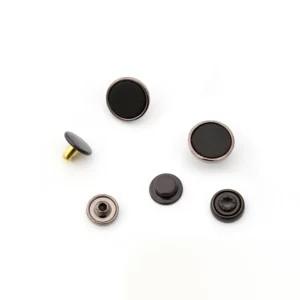Shank buttons and flat buttons differ in their construction and attachment methods.
Here are the main differences between the two:
Shank Buttons:
Construction: Shank buttons have a protruding loop or stem (called a shank) on the backside instead of a flat surface.
Attachment: They are attached to the garment by sewing the shank onto the fabric using a thread.
Stability: The shank creates a space between the button and the fabric, allowing room for the button to sit slightly above the fabric surface. This adds stability and prevents the button from pulling or puckering the fabric when fastened.
Buttonholes: Shank buttons typically require larger buttonholes to accommodate the shank.
Design Options: Shank buttons come in various sizes, shapes, and designs, including decorative and elaborate styles. They are commonly used for heavy or thick fabrics, as well as for aesthetic purposes.
Flat Buttons:
Construction: Flat buttons have a flat surface on the backside, with holes or a button shank directly attached to the back.
Attachment: They are sewn onto the garment by passing the thread through the holes or the shank on the back.
Buttonholes: Flat buttons require smaller buttonholes that fit through the holes or shank.
Versatility: Flat buttons are versatile and can be used for a wide range of fabrics and garments.
Design Options: Flat buttons come in various sizes, shapes, and materials. They can be simple or ornamental, depending on the desired style.
The choice between shank buttons and flat buttons depends on factors such as the fabric type, desired look, functional requirements, and personal preference. Shank buttons are often used for decorative or heavy-duty purposes, while flat buttons are more commonly used in everyday clothing and versatile applications.
How do snap buttons differ from sew-on buttons?
Snap buttons and sew-on buttons differ in their attachment methods and functionality. Here are the main differences between the two:
Snap Buttons:
Attachment: Snap buttons consist of two separate components, namely the socket (female) and the stud (male). They are attached by pressing the stud and socket together, creating a secure closure.
Functionality: Snap buttons provide a convenient and quick way to open and close garments. They are often used in applications where frequent fastening and unfastening are required, such as on shirts, jackets, and baby clothing.
Versatility: Snap buttons are available in various sizes, materials, and styles, allowing for customization and compatibility with different fabric types.
Installation: Installing snap buttons typically requires specialized tools, clothes button types such as snap pliers or a snap press, to properly secure the components onto the fabric.
Reusability: Snap buttons can be opened and closed repeatedly without significant wear or damage, making them durable and suitable for garments that require frequent use and washing.
Sew-on Buttons:
Attachment: Sew-on buttons have holes or a shank on the back, which allows them to be sewn onto the fabric using a needle and thread.
Functionality: Sew-on buttons provide a secure attachment and are commonly used for decorative or functional purposes. They are often found on shirts, blouses, pants, and other garments where a permanent closure is desired.
Versatility: Sew-on buttons come in various sizes, shapes, colors, and materials, providing a wide range of options for design and customization.
Installation: Sewing buttons onto the fabric requires basic sewing skills and can be done by hand or using a sewing machine. The attachment method depends on the number of holes or the presence of a shank.
Reusability: Sew-on buttons can withstand repeated use and washing, but they may require occasional reinforcement or reattachment if the stitching becomes loose over time.
The choice between snap buttons and sew-on buttons depends on factors such as the garment type, desired functionality, ease of attachment, and personal preference. Snap buttons offer quick closure and easy removal, while sew-on buttons provide a more traditional and permanent attachment method with a wide range of design options.
